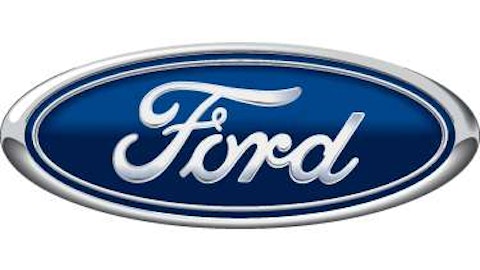Beware: I suspect this article will please precisely no one. Consider yourself forewarned.
After two weeks that have seen two The Boeing Company (NYSE:BA) planes left burning on the tarmac, I’ve been asked to remind investors of the bigger picture at Boeing — to pen a piece on the seven planes that made The Boeing Company (NYSE:BA) great.
Of course, boiling down the history of a century-old plane builder to just seven important models must be an exercise in triage. Do we limit our choices to Boeing qua The Boeing Company (NYSE:BA), or do McDonnell-Douglas (or even just Douglas) birds deserve to roost among these rankings? (Sure. Why not?) Do we count military warplanes, in addition to civilian airliners? (No. At least not in today’s column.) And how far back in time shall we search for the roots of The Boeing Company (NYSE:BA)’s greatness, and how far into the future dare we guess its success may reach?
The only certainty is this: Anyone who knows Boeing at all is going to disagree with at least some of these choices. So be it. Without further ado, here are my nominations for the seven planes that made The Boeing Company (NYSE:BA) a great company — and that give us some assurance this company has the staying power to remain great despite its recent setbacks.
Boeing 80

Boeing 80, Source: Boeing.
First flown in 1928, the Model 80 was the plane that got Boeing off the ground. It was the company’s first airplane built specifically for passenger transport, carrying first a dozen passengers, then later upgraded to the Model 80A-1, which could carry 18. It was the plane The Boeing built to compete with rival passenger aircraft from Fokker and (if you can believe it) Ford Motor Company (NYSE:F), and it eventually became the first plane with a stewardess on board to hand out refreshments (a registered nurse, Ellen Church, landed the first stewardess berth in 1930).
In its reconfigured 80A-1 iteration, the Model 80 sported an 80-foot wingspan and could fly as far as 460 miles.
Boeing 314 Clipper

Boeing 314, Source: Boeing.
Perception is a powerful thing. When selling an airplane to an airline, there can hardly be a more potent marketing tool than a line like this: “And did you know this is the plane the president picked to fly on?”
Well, in 1943, in the middle of World War II, President Franklin D. Roosevelt flew to Casablanca aboard the Dixie Clipper, a Boeing 314 — making the 314 the effectively the very first “Air Force One.” (They didn’t call it that, of course. Not least because at the time, the U.S. didn’t actually have an Air Force.)
The Boeing 314 enjoyed some commercial success as well. It was first flown in 1938, and 12 of the planes were built before WWII broke out. Designed to spec for Pan American World Airways as a “flying boat” capable of carrying passengers to Europe, the 314 could carry 74 passengers in style and boasted a flight range of 3,500 miles. With a wingspan of 152 feet, the deep-chested 314 was more than twice as big as the Model 80.
Douglas DC-3

Douglas DC-3, Source: Boeing.
Sometimes, great mergers create greater companies. If you’ve ever wondered why McDonnell Aircraft bought Douglas Aircraft in 1967, or why Boeing merged with McDonnell Douglas 30 years later, the answer can be summed up in one hyphenated word: DC-3.
It wasn’t as big as the Boeing 314, with a smaller wingspan and a shorter range. Yet Boeing modestly calls the DC-3, first flown in 1935, “the greatest airplane of its time,” and perhaps “the greatest of all time.” Many people agree.
Originally built for American Airlines (now US Airways Group Inc (NYSE:LCC) ), the plane soon gained a fan in United Airlines (now United Continental Holdings Inc (NYSE:UAL) ) — and then it went on to win sales contracts at nearly three dozen airlines and to (in alliance with its DC-2 predecessor) capture more than 90% of the air-passenger market. The DC-3 carried 28 passengers, or slept 14, which doesn’t sound like a lot in today’s terms. But it was the first plane capable of carrying enough passengers, and carrying them fuel-efficiently enough, to earn its airline owners a profit.
One testament to the plane’s quality? Hundreds of DC-3s are still flying today, nearly four score years after the plane was first built.
Boeing 707

Boeing 707, Source: Boeing.
Built around the bones of the KC-135 military aerial refueling tanker in 1957, the Boeing 707 got off to a troubled start. Not all that unlike with the 787 today, The Boeing Company (NYSE:BA) made a lot of big bets on the 707, and these bets came to define the company — and the industry, in time.
For example, the 707 standardized Boeing and industry practice of putting the passenger door on the left side of the plane, and installing doors both fore and aft. Boeing also gambled big on customizing the base model plane (130-foot wingspan, 3,000-mile range) to the requirements of multiple customers. It built longer-range models for far-off Australia’s Qantas Airways, and it tweaked the plane to accept bigger engines for high-altitude flights among South American airlines. That was quite a change from the old practice of drawing up entirely new airplanes at the request of individual customers such as American and United.
Such tweaks cost some money, sure. But they also helped Boeing grab market share from rival Douglas Aircraft. Ultimately, Boeing sold 856 of the planes.
Boeing 737

Boeing 737, Source: Boeing.
Forty-six years young and still going strong, our next entree on the Boeing’s best planes-list is a no-brainer: the Boeing 737. 93.7 feet long, and with a 93-foot wingspan, the original 737 was nicknamed “the square” for its nearly equal measurements. It flew 1,150 miles on a full tank of gas and carried as many as 107 passengers. Later versions, running up through today’s 737 Next Generation and 737 MAX iterations, can carry as many as twice that number.
Currently en route to delivering well over 10,000 planes, with more than 7,000 already in the hands of its customers, the 737 is the most successful commercial airplane ever built. Now in its fifth decade of production, the 737 remains so popular that Boeing quite literally cannot build the planes fast enough to keep up with demand.
Boeing 747

Boeing 747, Source: Boeing.
Boeing designed and built the world’s first jumbo jet in just 16 months, and then got it airborne in 1969. Perhaps Boeing’s most iconic airplane, the first Boeing 747 stood six stories tall and weighed nearly 370 tons. It was so big that Boeing had to construct an entirely new factory to build it. The existing workplaces just didn’t fit.
For nearly 40 years, it was the world’s biggest passenger jet, carrying as many as 550 passengers on flights as long as 6,000 miles. Needless to say, it’s still flying today. In fact, just last week Boeing sold two more of them. (Freighter versions).
Boeing 777

Boeing 777, Source: Boeing.
Last but not least — and really, not even last — we’ll end this list with the plane that inspired it: the Boeing 777, which crash-landed and caught fire at San Francisco International Airport last weekend — yet was so well built that it managed to keep all but two passengers alive through the crash, out of hundreds aboard.
How great is the 777, and how helpful is its reputation to Boeing? It’s great enough that last week’s crash was only the second significant accident recorded in the Triple-7’s 18-year history. Great enough that, according to famed Capt. Chesley “Sully” Sullenberger, last weekend was the only recorded instance in which a passenger aboard a 777 died. And it’s great enough to have persuaded Boeing’s customers to line up and buy 1,100 777s over the years.
The biggest twin-engine commercial jet in the world, the 777 was Boeing’s first plane to be designed entirely on computer using 3-D graphics. It sports wings spanning nearly 200 feet, a range upwards of 8,000 miles, and capacity to haul up to 440 passengers more than one-third of the way around the earth before needing to refuel.
Foolish takeaway
Boeing’s planes have, and Boeing’s stock has, stood the test of time — 97 years, to be precise. Does all this prove conclusively that Boeing stock should be bought today, at a 19 P/E ratio? Maybe, maybe not. But before you count Boeing out over a couple of mishaps, remember — its biggest rival today, Airbus parent EADS , costs more than 25 times earnings. And EADS has only been around since 2000.
Seems to me that investors who are valuing Boeing at a discount to its less-proven rival are doing Boeing a disservice.
The article 7 (Civilian) Planes That Made Boeing Great originally appeared on Fool.com and is written by Rich Smith.
Fool contributor Rich Smith has no position in any stocks mentioned. The Motley Fool recommends and owns shares of Ford and Nike.
Copyright © 1995 – 2013 The Motley Fool, LLC. All rights reserved. The Motley Fool has a disclosure policy.



